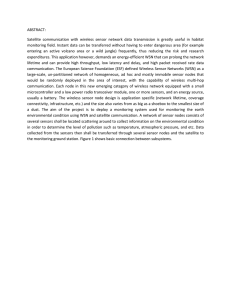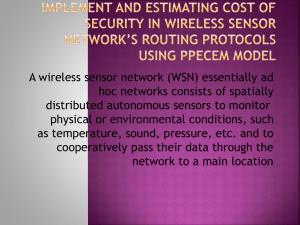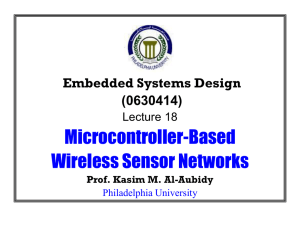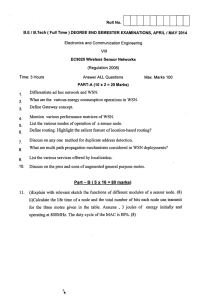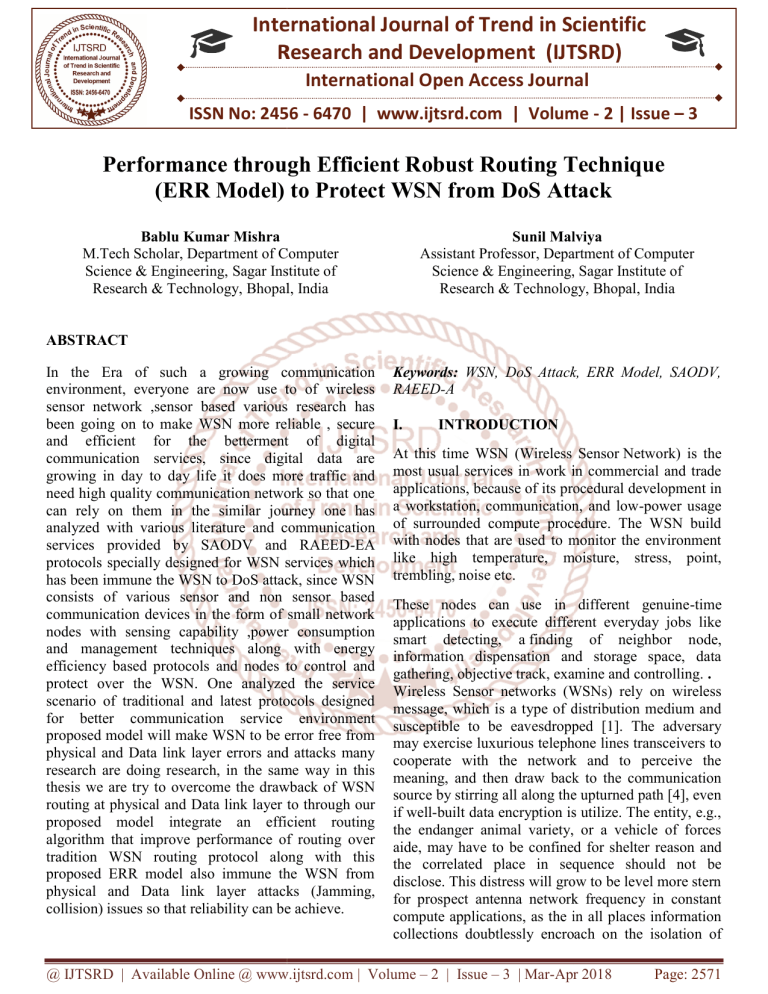
International Journal of Trend in Scientific
Research and Development (IJTSRD)
International Open Access Journal
ISSN No: 2456 - 6470 | www.ijtsrd.com | Volume - 2 | Issue – 3
Performance through Efficient Robust Routing Technique
(ERR Model) to Protect WSN from DoS Attack
Bablu Kumar Mishra
M.Tech Scholar, Department of Computer
Science & Engineering, Sagar Institute of
Research & Technology, Bhopal, India
Sunil Malviya
Assistant Professor,
essor, Department of Computer
Science & Engineering, Sagar Institute of
Research & Technology, Bhopal,
Bhopal India
ABSTRACT
In the Era of such a growing communication
environment, everyone are now use to of wireless
sensor network ,sensor based various research has
been going on to make WSN more reliable , secure
and efficient for the betterment of digital
communication services, since digital data are
growing in day to day life it does more traffic and
need high quality communication network so that one
can rely on them in the similar journey one has
analyzed with various literature and communica
communication
services provided by SAODV and RAEED
RAEED-EA
protocols specially designed for WSN services which
has been immune the WSN to DoS attack, since WSN
consists of various sensor and non sensor based
communication devices in the form of small network
nodes with sensing capability ,power consumption
and management techniques along with energy
efficiency based protocols and nodes to control and
protect over the WSN. One analyzed the service
scenario of traditional and latest protocols designed
for better communication
ion service environment
proposed model will make WSN to be error free from
physical and Data link layer errors and attacks many
research are doing research, in the same way in this
thesis we are try to overcome the drawback of WSN
routing at physical and Data
ata link layer to through our
proposed model integrate an efficient routing
algorithm that improve performance of routing over
tradition WSN routing protocol along with this
proposed ERR model also immune the WSN from
physical and Data link layer attacks ((Jamming,
collision) issues so that reliability can be achieve.
Keywords: WSN, DoS Attack, ERR Model, SAODV,
RAEED-A
I.
INTRODUCTION
At this time WSN (Wireless Sensor Network) is the
most usual services in work in commercial and trade
applications, because of its procedural development in
a workstation, communication, and low-power
low
usage
of surrounded compute procedure. The WSN build
with nodes that are used to monitor the environment
like high temperature, moisture, stress, point,
trembling, noise etc.
These nodes can use in different genuine-time
genuine
applications to execute different everyday jobs like
smart detecting, a finding of neighbor node,
information dispensation and storage space, data
gathering, objective track, examine and controlling. .
Wireless Sensor networks (WSNs) rely on wireless
message, which is a type of distribution medium and
susceptible to be eavesdropped [1]. The adversary
may exercise luxurious telephone lines transceivers to
cooperate with the network and to perceive the
meaning,
ning, and then draw back to the communication
source by stirring all along the upturned path [4], even
if well-built
built data encryption is utilize. The entity, e.g.,
the endanger animal variety, or a vehicle of forces
aide, may have to be confined for shelter reason and
the correlated place in sequence should not be
disclose. This distress will grow to be level more stern
for prospect antenna network frequency in constant
compute applications, as the in all places information
collections doubtlessly encroach on
o the isolation of
@ IJTSRD | Available Online @ www.ijtsrd.com | Volume – 2 | Issue – 3 | Mar-Apr
Apr 2018
Page: 2571
International Journal of Trend in Scientific Research and Development (IJTSRD) ISSN: 2456-6470
the public complicated [3]. a lot of technique to talk to
the cause position isolation concern have been
projected, see [4],where specter routing is one of the
in style approaches for preserve WSN as per the need
of its user.
consumption and utilization of nodes as result also
down reduce the WS network life, but also get
prospect of data congestion and down the
effectiveness of packet spreading. It is still a big
problem and lots of research has been going on.
II.
III.
RELATED WORK
The privacy from the various problems related to
threats that be present in wireless sensor networks
largely classify along two proportions likely (i)
substance-based confidentiality threats and (ii)
circumstance-based confidentiality threats [4]. While
substance-based confidentiality threats are well silent
[1], with cryptographic technique frequently being use
to attend to these issue [9], cryptographic methods do
not find circumstance-based confidentiality threats
and circumstance-based confidentiality threats has
challenge [10]. One significant feature of
circumstance-based confidentiality threats in several
applications is resource protection. There are various
research of sender location security protection in
wireless sensor networks [5] and the previous study
works can be divided into different parts based on
hackers skills, called node security preservation
protocol for maintaining local nodes attacks [6], and
resources protection security preservation protocol for
universal node attacks [1]. In order to get protection
universal node attacker against to universal node
monitoring in [9] proposed WSN Rate protocol, in
which no matter whether the original information is
received, all nodes in the entire network from WSN
will transmit data signals with specific rate of
transmission. This protocol efficiently works against
the universal node traffic analysis from different
attacks.
As an extension, a local network WSN protocol is
proposed in [2], where few sensor host works as local
can have out duplicate data , so that it decreasing
network load to some scope. In [6] proposed new Rate
protocol. By defining the node based data
transmission rate, the source address privacy can be
preserved protected and the manage delay can be also
compact. Authors in [9] introduced a new scheme
called Optimal Filtering protocols communication
Scheme to increase the network capacity to manage
node and its life time to get preserve against universal
hackers or attackers. However, for the universal
hackers or attackers, in [8] have limitations. Since all
host systems are transmitting a large scale fake or
duplicate packets, which would increase the energy
LITERATURE SURVEY
In [3] An Evolutionary method to get betters the
capacity of the Wireless sensor network”. Here one
worked on the technique that how power effectiveness
in the wireless sensor network is amplified by
inherent algorithm scheme? Inherent algorithm
scheme are practical in such a way to diminish the
unnecessary data to the go down and protect its power
funds, thereby, growing the capacity of nodes [3]. In
[4], study was done, how a complete network patterns
can be made for system delay in university grounds
environment. The network interruption measures base
on broadcast interruption and transmission delay. This
network pattern can use to assess and examine
network delay performance for research and
preparation purposes. In [6], model of a multi-node
self-organize wireless antenna set-up has been
discuss. The idea of the implementation was to
inspect, the presentation of self-connected wireless
network design. In this way, such parameters as
system configuration time, data packet transmission
routine, throughput, and tool responsibility series have
been examine. In addition, the contact of access
protocols. In [7], various types of map-reading
protocols are discussed. Where channel level
communication, modifiable code and path fix were
implementing and evaluate. Connection level
regeneration manages link break and disputation very
proficiently. Modifiable code introduces fixed cost.
path fix immune by repeated losses, increasing
convenience of modifiable code. In [8], routing
protocols related with the cost relevant with energy
that has been not used at each node of data transfer
was detailed as earlier. They terminate that when only
the communication energy is careful as the cost
required, by means of shorter multi-hop relations
seem to be more beneficial. In [9] the accessibility of
wireless nodes is measured by the prism of node
planning. They have checked the framework of sensor
nodes that go with distance in – the area of testing
parts which is must for raising the accessibility of
WSNs. with COTS specifications tested system test
interfaces for distance node testing, restore and
software improve. The framework provided most
favorable utilization.
@ IJTSRD | Available Online @ www.ijtsrd.com | Volume – 2 | Issue – 3 | Mar-Apr 2018
Page: 2572
International Journal of Trend in Scientific Research and Development (IJTSRD) ISSN: 2456-6470
2456
In [10] they have work on WSN nodes and assemble
them in cellular arrangement, to optimize the
reporting area, consistency in
Getting in sequence from the nodes and minimize
beating of information’s are enhanced. These design
arrangements
rrangements provide current explanation to sanctuary
vital and forces applications [2].
IV.
To simulate denial of service attacks against an
Internet web server;; Then to successfully defend
against those attacks.
Proposed ERR model will focus on the errors
raised at physical layer during communication like
to
o avoid Jamming Attack to maintain the
performance and reliability of WSN.
ERR ALGORITHM
Initialized all the Nodes, Shield Nodes, Target
node (Original Server), along with its initial
values.
Now enabled Shield server nodes to get accept
and reject connections with original server node.
Maintain cache node to manage wait for
connection states. For all the upcoming and
current connection requests.
To verify connection authentication perform auto
authentication process via shield nodes to check
check:
Whether Source exceeds its connection limit?
If yes then it reject the connection request
since it may be DoS client, otherwise go to
next.
Check whether Source exceeds its bandwidth
limit? If yes then again the shield node will
reject the connection request
uest since it may be
DoS client otherwise the request has been
accepted for further connection process and
data accessing permissions.
Client would be acknowledged and accepted for
the connection with original target server.
Connection established.
Receive server response.
In this way a shield based routing techniques gets best
favorable solution to us to get opt the routing efficient
and also get perceive the network from the major
error oriented networking situation that defines how
the network grow as high as possible along with the
security concern and specification for the purpose of
routing at WSN.
V. OBJECTIVES AND FLOW OF ERR
WSN is a very challenging area of networking,
many researchers is working on the problem
statements, in this thesis we try to achieve
following objectives.
Fig.1 Flow chart of Efficient Robust Routing
Technique in WSN
CONCLUSION
In the beginning of this paper we explain about the
proposed technique in WSN along with we discussed
the introduction of our proposed model, in further
section we define related work and traditional
methods used towards to get the objectives, in the
next section we go through the literature analysis,
objectives and proposed algorithm with flow chart
through
gh which we are trying to develop and
implement an Efficient WSN algorithm to overcome
from the problem occurred via DoS attack in WSN.
At the end we can say the implementation module
proposed by us will find better result compare to the
previous techniquess and algorithm.
@ IJTSRD | Available Online @ www.ijtsrd.com | Volume – 2 | Issue – 3 | Mar-Apr
Apr 2018
Page: 2573
International Journal of Trend in Scientific Research and Development (IJTSRD) ISSN: 2456-6470
REFERENCES
1. Khan, A., Sensors Lifetime Enhancement
Techniques in Wireless SensorNetworks - A
Survey Journal of Computing, vol. 2, issue 5, May
2010.
2. Bachir, A., Dohler, M., Watteyne, T., Leung, K.,
MAC Essentials for Wireless Sensor Networks.
Communications Surveys & Tutorials, IEEE. Vol.
12, issue2, 2012 pp. 222-248.
3. Y. Yan, Y. Qian, H. Sharif, and D. Tipper, ``A
survey
on
smart
grid
communication
infrastructures: Motivations, requirements and
challenges,'' IEEE Commun. Surveys Tuts., vol.
15, no. 1, pp. 5_20,1st Quart., 2013.
4. Hui Jiang Energy big data: A survey, IEEE
Journal and Magzine, vol. 4, 2016, pp 38443861DOI: 10.1109/ACCESS.2016.2580581.
5. Adam B. published “Structural Health Monitoring
Using
Wireless
Sensor
Networks:
A
Comprehensive Survey in IEEE Communications
Surveys & Tutorials, VOL. 19, and NO. 3, Third
Quarter 2017.
6. Muhammad Asif1, Shafiullah Khan,” Quality of
Service of Routing Protocols in Wireless Sensor
Networks: A Review” vol. 5, 2017, pp 1846-1871,
DOI: 10.1109/ACCESS.2017.2654356
7. Sunil Kumar Singh,” A Survey On Successors Of
Leach Protocol” IEEE Access vol. 5, 2017, pp
4298-4328,DOI:10.1109/ACCESS.2017.2666082.
8. Victoria J. Hodge,” Wireless Sensor Networks for
Condition Monitoring in the Railway Industry: A
Survey”IEEE
Transactions
on
Intelligent
Transportation Systems, Vol. 16, No. 3, June
2015.
9. Hlabishi I. Kobo,” A Survey On Software-Defined
Wireless Sensor Networks: Challenges And
Design Requirements” vol. 5, 2017, pp 18721899, DOI:10.1109/ACCESS.2017.2666200.
10. Nikos Bizanis ,Fernando A. Kuipers,” SDN And
Virtualization Solutions For The Internet Of
Things: A Survey” vol. 4, 2016, pp 5591-5606,
DOI: 10.1109/ACCESS.2016.2607786.
@ IJTSRD | Available Online @ www.ijtsrd.com | Volume – 2 | Issue – 3 | Mar-Apr 2018
Page: 2574

